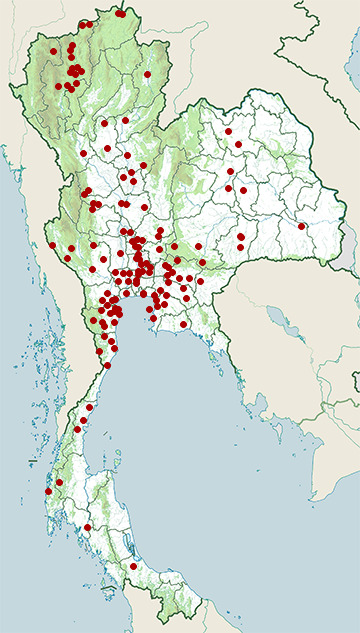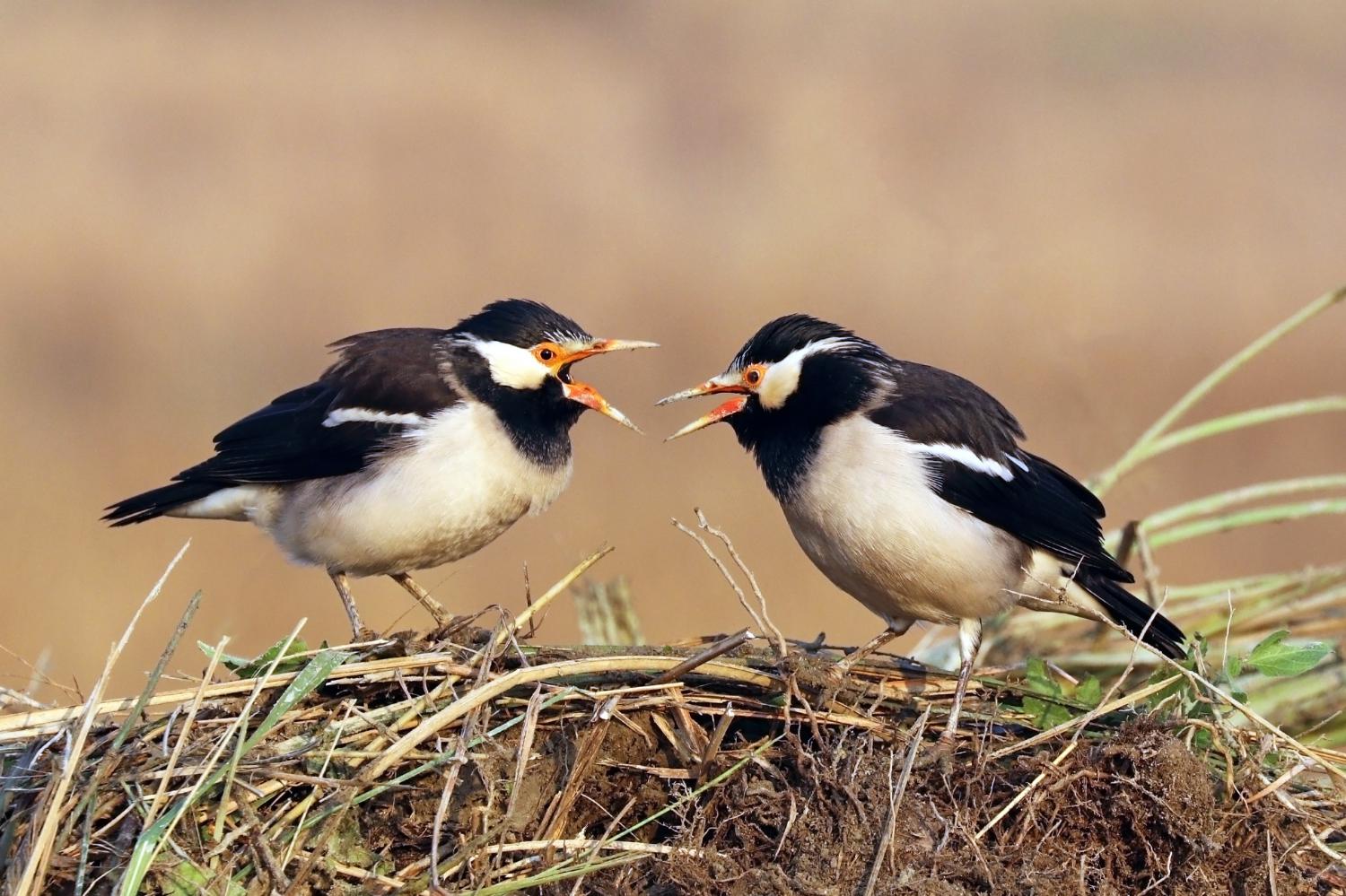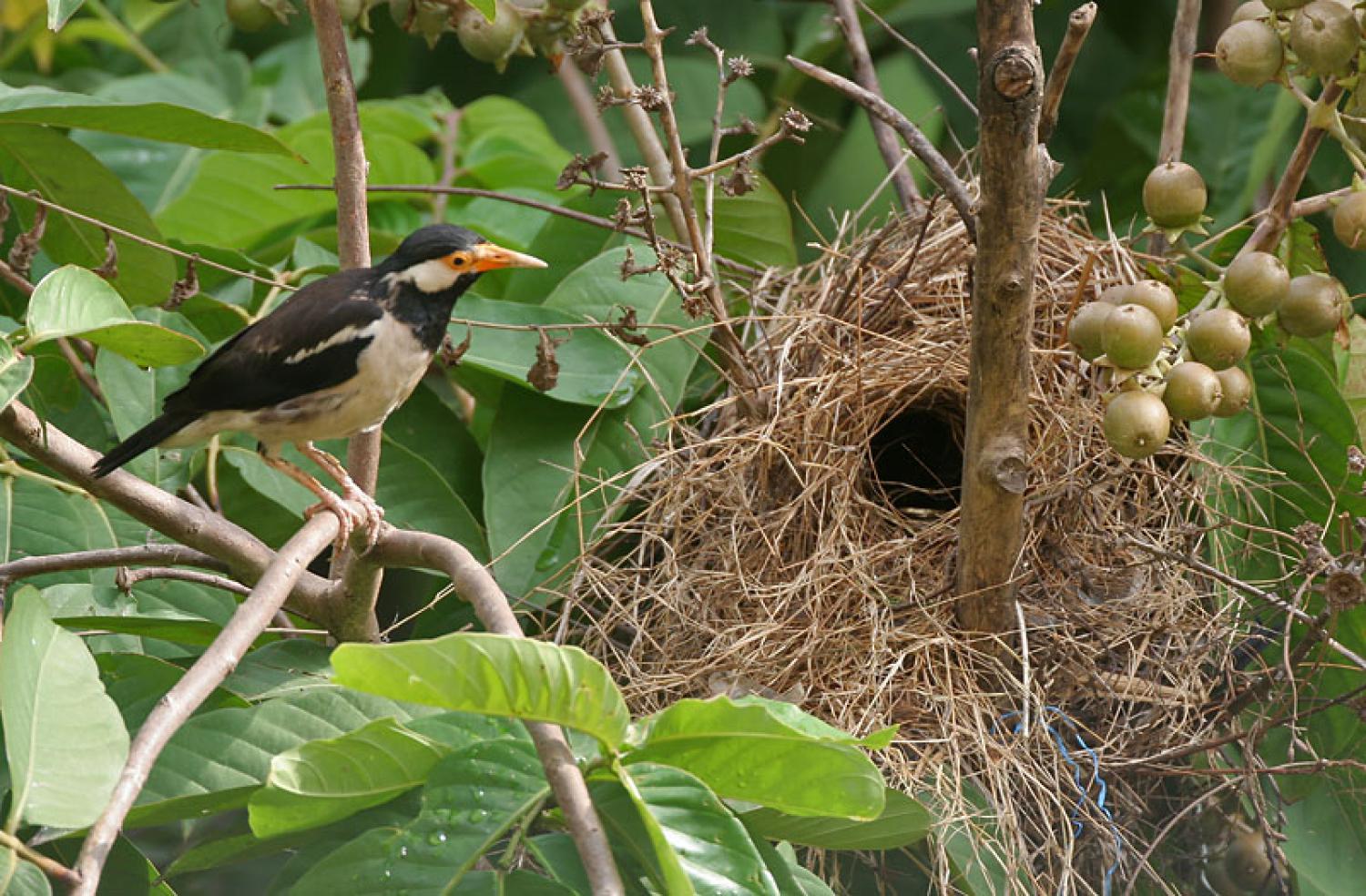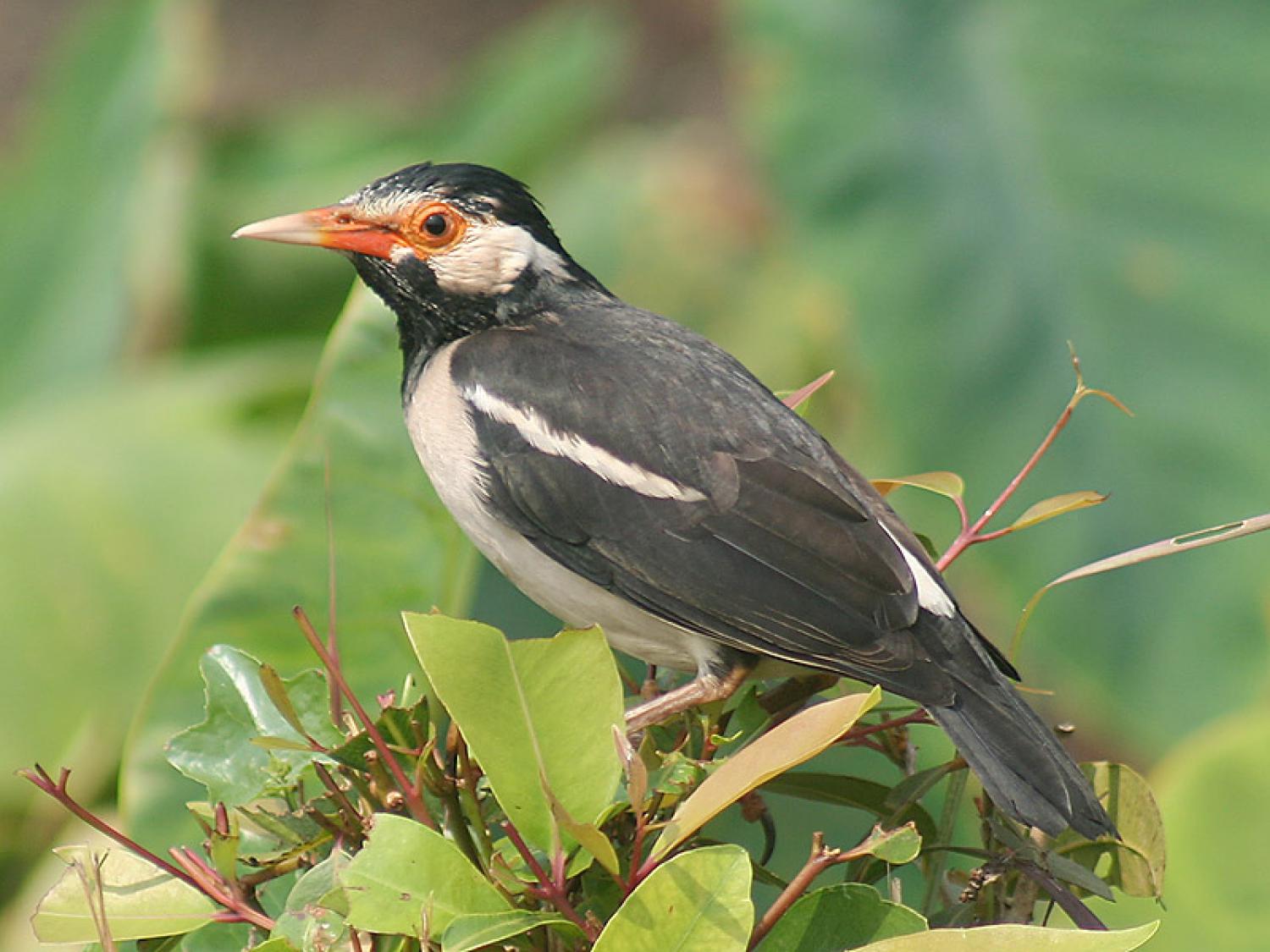Species of Thailand
Asian pied myna
Gracupica contra
Carolus Linnaeus, 1758
In Thai: นกเอี้ยงด่าง
The pied myna or Asian pied starling (Gracupica contra) is a species of starling found in the Indian subcontinent and Southeast Asia. They are usually found in small groups mainly on the plains and low foothills. They are often seen within cities and villages although they are not as bold as the common myna. They produce a range of calls made up of liquid notes. Several slight plumage variations exist in the populations and about five subspecies are named.
Taxonomy
The species has been included in the genus Sturnus and Sturnopastor in the past but recent studies do not support its inclusion within Sturnus leading to the reinstatement of an older genus name Gracupica. It has been claimed that the species name "contra" is derived from an Indian name for it, although this has not been traced subsequently.
The nominate subspecies (based on the species description given by Linnaeus in 1758) is found mainly along the Gangetic plains extending south into Andhra Pradesh and east to Bangladesh. The population in northeastern India (Sadiya to Tirap and the Naga Hills) was named as sordida (originally Sturnus contra sordidus) by Sidney Dillon Ripley in 1950. This form differs from the Indian form in having reduced streaking on the shoulders and nape. The populations in Manipur south to Myanmar and east to Yunnan have the white extending over the eye and are included in the subspecies superciliaris first described by Edward Blyth in 1863. The subspecies in Thailand, Laos and Cambodia is included in floweri ( Sharpe, 1897) while jalla described by Horsfield in 1821 is found on Sumatra, Java and Bali.
Description
This myna is strikingly marked in black and white and has a yellowish bill with a reddish bill base. The bare skin around the eye is reddish. The upper body, throat and breast are black while the cheek, lores, wing coverts and rump are contrastingly white. The sexes are similar in plumage but young birds have dark brown in place of black. The subspecies vary slightly in plumage, extent of streaking of the feathers and in measurements.
The flight is slow and butterfly-like on round wings.
Leucistic individuals have been recorded.
Distribution and habitat
The species is found mainly in the plains but in the foothills up to about 700m above sea level. They are found mainly in areas with access to open water. Their main distribution in India is from the Gangetic plains extending south to the Krishna River. Their range is increasing, with populations establishing more recently in Pakistan, Rajkot, and Bombay (since 1953), possibly aided by trade in caged birds and accidental escape. Their westerward spread in India particularly in parts of Rajasthan has been aided by changes in irrigation and farming patterns, and the spread into Sumatra has been aided by deforestation. The species has also established itself in Dubai, UAE.
The habitat is lowland open areas with scattered trees near water, often near human habitation. This species is often seen at sewage farms and refuse tips.
Behaviour
These starlings are usually found in small groups, foraging mainly on the ground but perching on trees and buildings. Birds in a group call frequently with a wide repertoire that includes whistles, trills, buzzes, clicks, and warbling calls. Young birds taken into captivity have been trained to imitate tunes of other birds.
Both sexes sing. They forage in fields, lawns and on open ground feeding on grains, fruit, insects, earthworms and molluscs usually taken from the ground. Like many other starlings, they often use a prying or gaping action, piercing soil and then opening apart the bill to dislodge hidden food. The strong protractor muscles allow them to part a mat of grass and their eyes are positioned to obtain a binocular view of the space between the parted beak. They often feed in grazing land or among cattle.
The breeding season in India is spread from March to September. With the onset of breeding, the sizes of flocks decline and birds pair up. Courtship involves calling, fluffing of the feathers and head bobbing. The nest is a loose mass of straw formed into a dome with an entrance on the side and placed in a large tree (often banyan, mango, jackfruit, rosewood) or sometimes on man-made structures, often close to human habitation. Several pairs will breed in the same vicinity. The usual clutch is made up of about four to six glossy blue eggs. Each egg is laid with a day in between and incubation begins only after the third or fourth egg is laid. The eggs hatch after 14 to 15 days. The young are brooded for two weeks, the female staying at the nest during the night. Both parents feed the chicks until they fledge and leave after three weeks. More than one brood may be raised in a season.
An instance of interspecific feeding, where an adult of a common myna fed a young pied myna has been reported.
These mynas form communal roosts at night and jointly defend nesting areas.
In culture
The ability of these mynas to mimic human voices made them popular as cagebirds. The Sema Nagas will not eat this bird as they believe it is the reincarnation of a human. They are considered to be generally beneficial because they eat many insects.
This article uses material from Wikipedia released under the Creative Commons Attribution-Share-Alike Licence 3.0. Eventual photos shown in this page may or may not be from Wikipedia, please see the license details for photos in photo by-lines.
Category / Seasonal Status
BCST Category: Recorded in an apparently wild state within the last 50 years
BCST Seasonal status: Resident or presumed resident
Scientific classification
- Kingdom
- Animalia
- Phylum
- Chordata
- Class
- Aves
- Order
- Passeriformes
- Family
- Sturnidae
- Genus
- Gracupica
- Species
- Gracupica contra
Common names
- Thai: นกเอี้ยงด่าง
Synonyms
- Sturnus contra
Conservation status

Least Concern (IUCN3.1)
Photos
Please help us review the bird photos if wrong ones are used. We can be reached via our contact us page.
Range Map

- Amphawa District, Samut Songkhram
- Ban Bueng District, Chonburi
- Ban Laem District, Phetchaburi
- Ban Lat District, Phetchaburi
- Ban Phai District, Khon Kaen
- Ban Pho District, Chachoengsao
- Ban Phraek District, Phra Nakhon Si Ayutthaya
- Ban Sang District, Prachinburi
- Bang Ban District, Phra Nakhon Si Ayutthaya
- Bang Lamung District, Chonburi
- Bang Len District, Nakhon Pathom
- Bang Pa In District, Phra Nakhon Si Ayutthaya
- Bang Pahan District, Phra Nakhon Si Ayutthaya
- Bang Pakong District, Chachoengsao
- Bang Phra Non-Hunting Area
- Bang Pu Recreation Centre
- Bangkok Province
- Borabue District, Maha Sarakham
- Bueng Boraped Non-Hunting Area
- Chaiyo District, Ang Thong
- Chiang Dao District, Chiang Mai
- Chiang Dao Wildlife Sanctuary
- Chiang Saen District, Chiang Rai
- Chum Ta Bong District, Nakhon Sawan
- Doi Inthanon National Park
- Doi Lo District, Chiang Mai
- Doi Pha Hom Pok National Park
- Doi Saket District, Chiang Mai
- Doi Suthep - Pui National Park
- Hat Yai District, Songkhla
- Hua Hin District, Prachuap Khiri Khan
- Huai Chorakhe Mak Reservoir Non-Hunting Area
- Huai Krachao District, Kanchanaburi
- Huai Talat Reservoir Non-Hunting Area
- In Buri District, Sing Buri
- Kabin Buri District, Prachinburi
- Kaeng Khoi District, Saraburi
- Kaeng Krachan District, Phetchaburi
- Kaeng Krachan National Park
- Kamphaeng Saen District, Nakhon Pathom
- Kanthararom District, Sisaket
- Khao Nang Phanthurat Forest Park
- Khao Phra - Bang Khram Wildlife Sanctuary
- Khao Sam Roi Yot National Park
- Khao Sok National Park
- Khao Yai National Park
- Khao Yoi District, Phetchaburi
- Khlong Luang District, Pathum Thani
- Klaeng District, Rayong
- Ko Sichang District, Chonburi
- Kui Buri National Park
- Kumphawapi District, Udon Thani
- Laem Pak Bia
- Lan Sak District, Uthai Thani
- Mae Ai District, Chiang Mai
- Mae Poen District, Nakhon Sawan
- Mae Rim District, Chiang Mai
- Mae Taeng District, Chiang Mai
- Mae Wong National Park
- Mueang Chiang Mai District, Chiang Mai
- Mueang Chonburi District, Chonburi
- Mueang Chumphon District, Chumphon
- Mueang Kanchanaburi District, Kanchanaburi
- Mueang Khon Kaen District, Khon Kaen
- Mueang Lamphun District, Lamphun
- Mueang Lopburi District, Lopburi
- Mueang Nakhon Nayok District, Nakhon Nayok
- Mueang Nakhon Pathom District, Nakhon Pathom
- Mueang Nakhon Sawan District, Nakhon Sawan
- Mueang Nan District, Nan
- Mueang Nonthaburi District, Nonthaburi
- Mueang Pathum Thani District, Pathum Thani
- Mueang Phetchaburi District, Phetchaburi
- Mueang Phichit District, Phichit
- Mueang Phitsanulok District, Phitsanulok
- Mueang Prachinburi District, Prachinburi
- Mueang Prachuap Khiri Khan District, Prachuap Khiri Khan
- Mueang Ratchaburi District, Ratchaburi
- Mueang Sa Kaeo District, Sa Kaeo
- Mueang Samut Sakhon District, Samut Sakhon
- Mueang Samut Songkhram District, Samut Songkhram
- Mueang Sukhothai District, Sukhothai
- Mueang Suphanburi District, Suphan Buri
- Mueang Tak District, Tak
- Mueang Udon Thani District, Udon Thani
- Mueang Uttaradit District, Uttaradit
- Noen Maprang District, Phitsanulok
- Nong Bong Khai Non-Hunting Area
- Nong Prue District, Kanchanaburi
- Nong Suea District, Pathum Thani
- Nong Ya Plong District, Phetchaburi
- Pa Sak Chonlasit Dam Non-Hunting Area
- Pa Sang District, Lamphun
- Pai District, Mae Hong Son
- Pak Chong District, Nakhon Ratchasima
- Pak Phli District, Nakhon Nayok
- Pak Thale
- Pak Tho District, Ratchaburi
- Pak Thong Chai District, Nakhon Ratchasima
- Pang Sila Thong District, Kamphaeng Phet
- Pathio District, Chumphon
- Phaisali District, Nakhon Sawan
- Phanat Nikhom District, Chonburi
- Phatthana Nikhom District, Lopburi
- Pho Prathap Chang District, Phichit
- Phra Nakhon Si Ayutthaya District, Phra Nakhon Si Ayutthaya
- Phutthamonthon District, Nakhon Pathom
- Pran Buri District, Prachuap Khiri Khan
- Ratchasan District, Chachoengsao
- Sai Noi District, Nonthaburi
- Sai Yok National Park
- Samut Prakan Province
- San Sai District, Chiang Mai
- Sanam Bin Reservoir Non-Hunting Area
- Sanam Chai Khet District, Chachoengsao
- Sankhaburi District, Chainat
- Sawi District, Chumphon
- Si Maha Phot District, Prachinburi
- Si Satchanalai District, Sukhothai
- Sri Nakarin Dam National Park
- Takua Pa District, Phang Nga
- Taphan Hin District, Phichit
- Tha Chang District, Sing Buri
- Tha Takiap District, Chachoengsao
- Tha Wung District, Lopburi
- Tha Yang District, Phetchaburi
- Thanyaburi District, Pathum Thani
- Thap Lan National Park
- Thong Pha Phum National Park
- Wang Noi District, Phra Nakhon Si Ayutthaya
- Wat Phai Lom & Wat Ampu Wararam Non-Hunting Area


